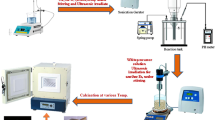Abstract
This paper reports a high-yield process to fabricate biomimetic hydroxyapatite nano-particles or nano-plates. Hydroxyapatite is obtained by simultaneous dripping of calcium chloride and ammonium hydrogen phosphate solutions into a reaction vessel. Reactions were carried out under various pH and temperature conditions. The morphology and phase composition of the precipitates were investigated using scanning electron microscope and X-ray diffraction. The analyses showed that large plates of calcium hydrophosphate are formed at neutral or acidic pH condition. Nanoparticles of hydroxyapatite were obtained in precipitates prepared at pH 9–11. Hydroxyapatite plates akin to seashell nacre were obtained at 40 °C and pH 9. This material holds promise to improve the strength of hydroxyapatite containing composites for bone implant or bone cement used in orthopaedic surgeries. The thermodynamics of the crystal growth under these conditions was discussed. An assembly mechanism of the hydroxyapatite plates was proposed according to the nanostructure observations.











Similar content being viewed by others
References
Meyers MA, Chen P-Y, Lin AY, Seki Y (2008) Biological materials: structure and mechanical properties. Prog Mater Sci 53:1–206
Gentleman E, Lay AN, Dickerson DA, Nauman EA, Livesay GA, Dee KC (2003) Mechanical characterization of collagen fibers and scaffolds for tissue engineering. Biomaterials 24:3805–3813
Yana J, Daga A, Kumar R, Mecholsky JJ (2008) Fracture toughness and work of fracture of hydrated, dehydrated, and ashed bovine bone. J Biomech 41:1929–1936
Kikuchi M, Ikoma T, Itoh S, Matsumoto H, Koyama Y, Takakuda K, Shinomiya K, Tanaka J (2004) Biomimetic synthesis of bone-like nanocomposites using the self-organization mechanism of hydroxyapatite and collagen. Compos Sci Technol 64:819–825
Kim H-W, Kim H-E, Salih V (2005) Stimulation of osteoblast responses to biomimetic nanocomposites of gelatin-hydroxyapatite for tissue engineering scaffolds. Biomaterials 26:5221–5230
Kikuchi M, Itoh S, Ichinose S, Shinomiya K, Tanaka J (2001) Self organisation mechanism in bone-like hydroxyapatite/collagen nanocomposite synthesized in vitro and its biological reaction in vivo. Biomaterials 22:1705–1711
Kikuchi M, Matsumoto HN, Yamada T, Koyama Y, Takakuda K, Tanaka J (2004) Glutaraldehyde cross-linked hydroxyapatite/collagen self-organized nanocomposites. Biomaterials 25:63–69
Zhang W, Liao SS, Cui FZ (2003) Hierarchical self-assembly of nano-fibrils in mineralised collagen. Chem Mater 15:3221–3226
Manara S, Paolucci F, Palazzo B, Marcaccio M, Foresti E, Tosi G, Sabbatini S, Sabatino P, Altankov G, Roveri N (2008) Electrochemically-assisted deposition of biomimetic hydroxyapatite–collagen coatings on titanium plate. Inorg Chim Acta 361:1634–1645
Muller FA, Muller L, Caillard D, Conforto E (2007) Preferred growth orientation of biomimetic apatite crystals. J Cryst Growth 304:464–471
Liu C, Huang Y, Shen W, Cui J (2001) Kinetics of hydroapatite precipitation at pH 10 to 11. Biomaterials 22:301–306
Liao S, Ngiam M, Watari F, Ramakrishna S, Chan CK (2007) Systematic fabrication of nano-carbonated hydroxyapatite/collagen composites for biomimetic bone grafts. Bioinspir Biomim 2:37–41
Rusu VM, Ng C-H, Wilke M, Tiersch B, Fratzl P, Peter MG (2005) Size-controlled hydroxyapatite nanoparticles as self-organized organic–inorganic composite materials. Biomaterials 26:5414–5426
Yunoki S, Ikoma T, Monkawa A, Ohta K, Kikuchi M, Sotome S, Shinomiya K, Tanaka J (2006) Control of pore structure and mechanical property in hydroxyapatite/collagen composite using unidirectional ice growth. Mater Lett 60:999–1002
Yoon B-H, Kim H-W, Lee S-H, Bae C-J, Koh Y-H, Kong Y-M, Kim H-E (2005) Stability and cellular responses to fluorapatite–collagen composites. Biomaterials 26:2957–2963
Viswanath B, Ravishankar N (2008) Controlled synthesis of plate—shaped hydroxyapatite and implications for the morphology of the apatite phase in bone. Biomaterials 29:4855–4863
Neira IS, Kolenko YV, Lebedev OL, Van Tendeloo G, Gupta HS, Guitian F, Yoshimura M (2009) An efficient morphology control of hydroxyapatite crystal via hydrothermal synthesis. Cryst Growth Des 9:466–474
Ma T, Xia Z, Liao L (2011) Effect of reaction systems and surfactant additives on the morphology evolution of hydroxyapatite nanorods obtained via a hydrothermal route. Appl Surf Sci 257:4384–4388
Rajkumar M, Sundaram NM, Rajendran V (2011) Preparation of size controlled, stoichiometric and bioresorbable hydroxyapatite nanorod by varying initial pH, Ca/P ratio and sintering temperature. Dig J Nanomater Biostruct 6:169–179
Zhang H-B, Zhou K, Li Z, Huang S (2000) Plate-like hydroxyapatite nanoparticles synthesized by the hydrothermal method. J Phys Chem Solids 70:243–248
Wang RZ, Suo Z, Evans AG, Yao N, Aksay IA (2001) Deformation mechanisms in nacre. J Mater Res 16:2485
Evans AG, Suo Z, Wang RZ, Aksay IA, He MY, Hutchinson JW (2001) Model for the robust mechanical behavior of nacre. J Mater Res 16:2475
Acknowledgements
The financial support from Tsinghua University National Key Lab of Advanced Ceramics and Fine Processing through National Laboratory Fund is gratefully acknowledged. The authors are obliged to colleagues at Tsinghua University, Dundee University and Plymouth University for their assistance with XRD and SEM analysis.
Author information
Authors and Affiliations
Corresponding author
Rights and permissions
About this article
Cite this article
Le, H.R., Chen, K.Y. & Wang, C.A. Effect of pH and temperature on the morphology and phases of co-precipitated hydroxyapatite. J Sol-Gel Sci Technol 61, 592–599 (2012). https://doi.org/10.1007/s10971-011-2665-7
Received:
Accepted:
Published:
Issue Date:
DOI: https://doi.org/10.1007/s10971-011-2665-7




